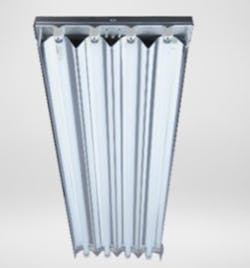Inside LED Metrics
Planning an LED retrofit? Low energy consumption and a long life make solid state lighting an attractive option, but deciphering the lighting metrics on product packages and spec sheets can be confusing.
This guide to the most common metrics used by LED vendors will help you understand what’s behind the ratings.
Lighting Facts Labels
The DOE established the LED Lighting Facts program to ensure one consistent source of information about all LED products. Lighting Facts labels include five basic metrics.
Color temperature (CCT): Color temperature characterizes how “cool” (blue) or “warm” (yellow) a white light appears. Ratings are expressed in Kelvins (K). Lower numbers around 2500-3000K indicate warmer light, mid-range values of 3500-4000K are generally considered fairly neutral and white, and higher temperatures appear cooler.
Color Rendering Index (CRI): This metric indicates how accurately a light surface renders color as determined by tests with color samples. The ratings typically fall into a 0-100 range, with a standard incandescent lamp achieving 100, though it’s possible to get a negative score. A source with a CRI in the 70s is acceptable for interior lighting, according to the DOE, but a CRI of 80-90 would be even better.
Two light sources that have the same CCT and CRI may still not render colors the same way, but the two factors still serve as a good starting point for evaluating color performance – the real test will come when you perform your own visual evaluation.
Lumen output: The quantity of light that leaves the lamp. The higher the number, the more light provided.
Watts: Lighting Facts labels also provide the input wattage of the lamp. Use it to project energy savings based on the lighting system you’re replacing with LEDs.
Efficacy: Expressed in lumens per watt, the efficacy rating denotes how much light the product puts out for every watt of electricity it uses.
Lifetime Metrics
In addition to the basics on energy input, lumen output and color performance, spec sheets offer a wealth of other information that can help you make a decision. Consider these metrics to help you narrow down your product choices.
Useful life: Lifetime ratings represent approximately how many hours of operation it will take before the LED’s light output has declined to 70% of the initial lumens, referred to as lumen maintenance and often abbreviated as L70. The DOE recommends asking the fixture manufacturer for test data to support the life claims on the package.
Expected lumen maintenance: The calculated L70 value sometimes exceeds the intended product use cycle or the lifetime of another lighting system component, the DOE explains. An alternative method of calculating lumen maintenance performance involves predicting what the lumen maintenance will be at a fixed time interval, such as 25,000 hours.
Compiled by Janelle Penny
